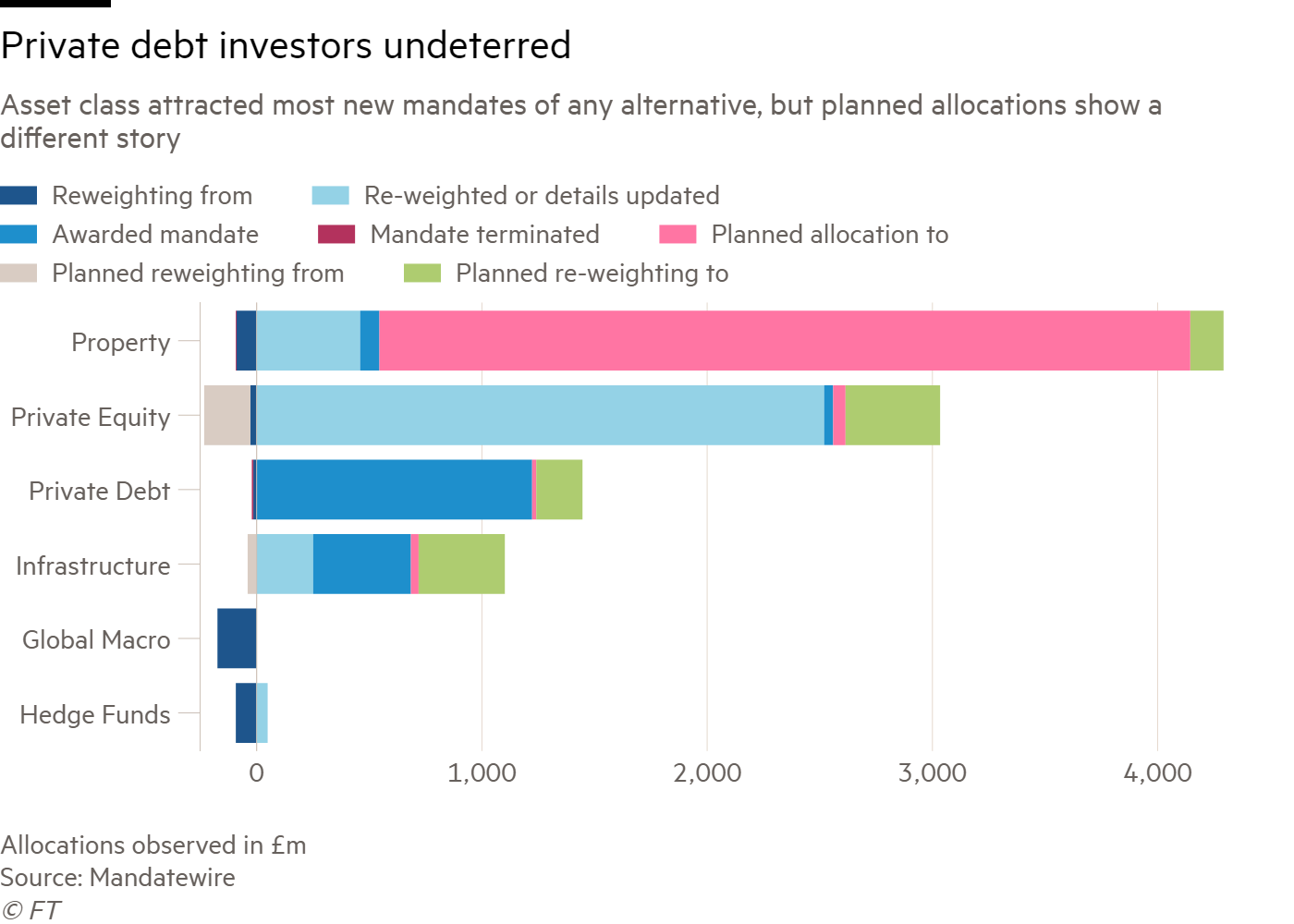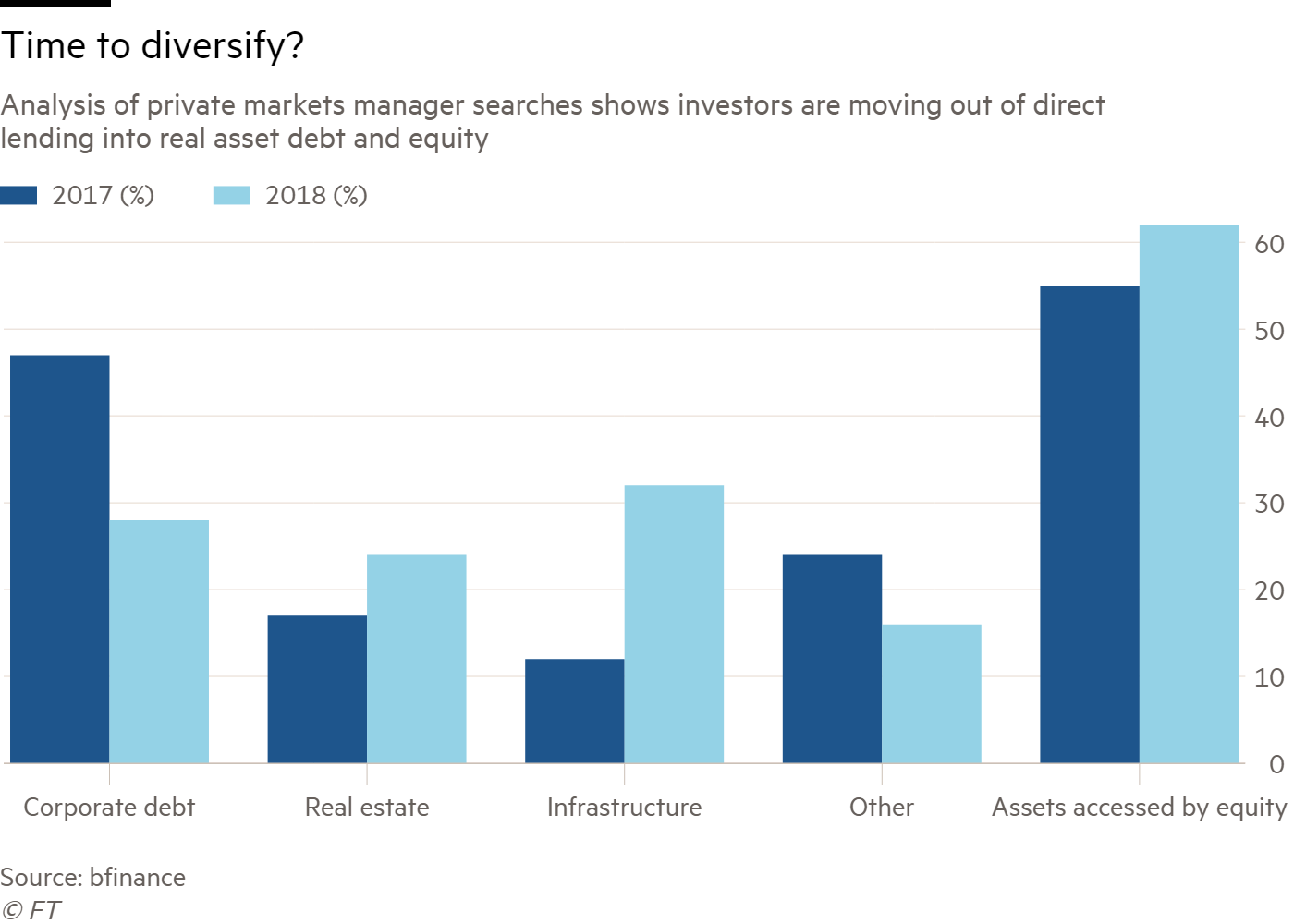Data crunch: Private debt received more mandate awards than any other alternative asset class in Q1 this year, according to MandateWire, but should trustees be concerned by the threat of corrections and weakening covenants?
“Within 12 to 18 months there is going to be a correction,” he says. “If 2008 was midnight at the party it’s quarter past 11 in my opinion… this is a moment now to be really clear and disciplined about your approach to investment.”
If 2008 was midnight at the party it’s quarter past 11 in my opinion. This is a moment now to be really clear and disciplined about your approach to investment
Patrick Marshall, Hermes Investment Management
If managers like Mr Marshall are sounding a note of caution, pension fund appetite for the asset class does not appear to be diminishing.
Data from Pensions Expert’s sister title MandateWire show that £1.2bn of new mandate awards were observed in the first quarter of 2019, comfortably leading the alternatives sector on that measure. Private equity also saw large inflows with reweightings worth £2.5bn, while property saw large planned allocations over the period.
Consultancy bfinance says overall allocations are on the rise, and it is “not uncommon” to see private debt account for 10 per cent of a portfolio.
Looser covenants leave investors exposed
Mr Marshall says he fears that at least some of these new private debt allocations are to managers taking risks that investors are not appropriately compensated for.
Of particular concern is the weakening of covenants in some areas of the private debt market, in particular with leveraged loans – the term used for larger, bank-syndicated private debt deals. Some 80 per cent of loans in that sector in 2018 were what is termed as ‘cov-lite’, meaning investors have fewer protections when things go wrong at the borrower company.

Mr Marshall complains that this deterioration diminishes one of the key advantages of private debt instruments over other fixed income, other than their floating rate payout – their protection and stability.
“You’ve got a bond-like structure so why not invest in a bond,” he says. “So many people have competed on loan terms. You’ve got so many cov-lite structures and the like that it becomes very hard to put a company into default.”
While default rates are not currently a threat to the asset class, rising interest rates will put companies under pressure, and Mr Marshall insists on stress-testing prospective loan companies up to 8 per cent rates.
Mr Marshall says that while managers do not want to even see defaults in their portfolio, the lack of protection means “you’re in a situation where a problem in a company can go on, and when the company finally hits the moment of reckoning, so much cash has left the company that your recovery is going to be much lower”.
While protections in senior secured direct lending funds are by definition greater, Mr Marshall also says that some managers include riskier debt structures such as second lien or mezzanine in their funds.
Senior debt offers safety
So will investors be scared off the asset class? Mandatewire data certainly show other illiquid assets streaking ahead in terms of planned allocations.
Similarly, analysis by consultancy bfinance shows that in 2017, corporate private debt accounted for 47 per cent of private markets manager searches, but by the end of 2018 this had fallen to 28 per cent and been overtaken by infrastructure searches.
However, Niels Bodenheim, the company’s senior director of private markets, says the picture is more nuanced than this, and that pension funds have not lost their faith in the asset class.
“Is it the right time to invest? I still think so – it’s finding the right pockets of opportunity and the right managers,” he says.

Mr Bodenheim says that while covenants outside the leverage loans space have not deteriorated to a worrying degree, “the concerns are more around the Ebitda adjustments that are allowed… what’s real cash flow and what’s fictitious cashflow”.
“Documentation as a whole continues to get pressure, but we don’t see necessarily the market going to cov-lite, although it’s come down slightly,” he says. Similarly, while he is concerned about the increasingly complex structure of unitranche debt, he says that most senior secured funds are some way off reaching the limits of their allowances for riskier debt structures.
These concerns should not be enough to dissuade pension schemes from investing. Mr Bodenheim says that under a “worst case scenario”, with investors suffering default rates of up to 4 per cent and not being able to recover anything from the insolvencies, the illiquidity premium of the asset class should leave schemes in positive territory.
“A lot has to go wrong before there is material loss,” he says, stressing that senior credit should always be a defensive asset. “That is why diversification is also very critical in all forms: number of underlying investments, manager diversification, regional diversification, vintage diversification etc.”
Future-proofing private debt
Diversification is all the more important given the prospect of troubled markets ahead, and investors appear to have got the message. In manager searches schemes are thinking about spreading their debt allocations across real assets as well as corporate lending.
Other aspects of what Mr Bodenheim calls a “flight to safety” include schemes preferring established larger private debt houses, and he recommends careful due diligence on managers’ team size and capability.
Will private credit become a mainstay of DC portfolios?
Analysis: Private credit is flavour of the month with yield-starved defined benefit funds, but has only attracted defined contribution business from the giants of the mastertrust sector. Could renegotiations on fees open up the asset class for today’s savers?
Important questions to ask include whether teams are “staffed appropriately and what is the composition of that staff… how many years of experience do those analysts have, how many members of that team have been through the crash”.
With several managers seeing key leadership changes even in the past 12 months, Mr Bodenheim says good teams will make better choices on loans, “but also have an appropriate process and structure to deal with the bad ones”.
“Even in the last 10 years there have been disruptions in the portfolios and there have been stressed events,” he says, recommending trustees look at this and also consider whether fees on their current allocations remain appropriate. “I firmly believe that especially some of the European offerings are underweight on staff for the amount of capital that they’ve raised.”






















